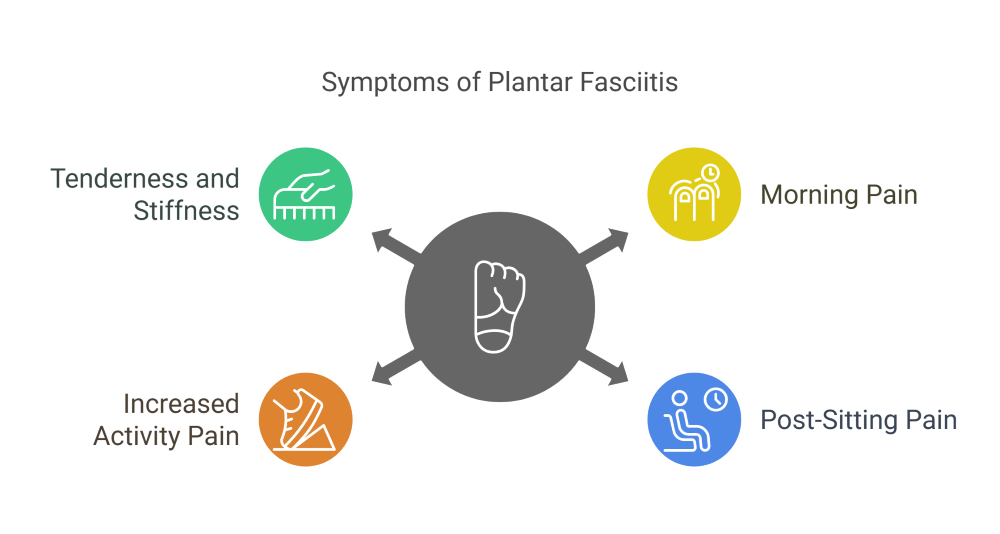If you spend hours on your feet, wear worn out shoes, or have high arches or flat feet, then you’re more likely to suffer from plantar fasciitis. You must contact a specialized physical therapy center as soon as you notice symptoms of plantar fasciitis.
Plantar Fasciitis Overview
The Plantar fascia, a thick and web-like fibrous band of connective tissue, is located on the base of the heel bone (calcaneus) and extends along the sole of your foot towards your toes. It serves as a shock absorber and supports the arch of the foot. Plantar fasciitis occurs when your plantar fascia becomes inflamed or develops micro-tears.
Plantar fasciitis is a painful condition, causing a stabbing pain, usually with your first steps out of bed in the morning. Getting up and moving on your feet often reduces the pain, but sitting or standing for a long duration can cause the pain to return.

Plantar fasciitis is more common in nurses, teachers, and runners. Also, people who are overweight or wear the wrong shoes are at higher risk of developing it. Plantar fasciitis is caused by either traction or compression injuries. Traction plantar fasciitis occurs when your plantar fascia is repeatedly stretched.
An elongated arched caused by weak foot arch muscles or poor foot biomechanics is a common reason for an overstretched plantar fascia. Compression plantar fasciitis occurs when you land on a sharp object that bruises or damages your plantar fascia. You will experience pain further under your arch instead of feeling it under your heel.
If you have been silently suffering from plantar fasciitis, Specialized Physical Therapy is here to help. You can schedule an appointment for plantar fascia physical therapy treatment with Dan, Michael, or Diana to find the underlying causes and start treatment to correct and manage it.
What Are Symptoms of Plantar Fasciitis?
The symptoms of plantar fasciitis include:
- Pain at the bottom of your foot close to your heel
- Tenderness and stiffness
- Pain after walking a few steps when you get up in the morning or after sitting or standing in one position for several hours such as car ride
- Increased pain after working out or physical activity
Plantar Fasciitis Common Causes
Plantar Fasciitis common causes include:
- Age-associated problems in individuals aged between 40 and 60
- Activities that place a lot of pressure on your heel and attached tissue (ballet dancing, long-distance running, and aerobic dance, prolonged static standing)
- Foot mechanics – people with flat feet/pes planus/fallen arches, a high arch, or an abnormal walking pattern. This can affect the distribution of weight when you stand, and place more pressure on the plantar fascia.
- Excess weight can put additional pressure on your plantar fascia.
- Certain occupations that require you to stand or walk on hard surfaces for most of the day can damage your plantar fascia (factory workers, guards, nurses, and teachers).
- Wearing worn-out shoes with thin soles or high heels.
- Having tight Achilles tendons or heel cords.
Plantar Fasciitis Diagnosis
Specialized Physical Therapy can confirm your Plantar Fasciitis diagnosis by performing an extensive physical examination. Our physical therapist will take a history of your symptoms. They will ask questions to understand your pain pattern. The main goal is to learn how your symptoms interfere with your everyday routine, and inquire about any help (at-home remedies and solutions) or doctors you may have visited for treatment in the past.
If you have an x-ray, bring it with you, as it may demonstrate calcification in your plantar fascia or at its insertion onto the calcaneus, which is called a heel spur or calcaneal spur. We will examine your foot and ankle mobility, muscle flexibility, the strength of your ankle/foot, and your ability to perform basic activities, such as walking and climbing stairs.
We will evaluate muscle and nerve health by checking your muscle tone, coordination, balance, and reflexes. Since shoes can cause plantar fasciitis, bring three shoes you commonly wear every day. If you wear a different pair of shoes to work, bring those as well. We will then create a personalized treatment plan to reduce your symptoms, decrease your pain, and improve your function.
Plantar Fasciitis Treatment and Exercises
Specialized Physical Therapy will create a treatment plan consisting of workouts and best practices to follow, including stretching, to treat plantar fasciitis. Our physical therapists will tell you about various active foot stabilization exercises that you can perform at home to manage your condition and ensure it does not return.
Our goal through plantar fasciitis physical therapy treatment is to help you regain a complete range of motion, restore foot biomechanics, increase leg strength. If you’re a runner, then we would like to improve your running and landing technique. That way, you may return to sport or work faster. We also perform a footwear analysis to determine if your shoes are the problem.
If you want to return to doing things you once loved and no longer want the pain to be the first thing you feel in the morning, contact us at 201-773-881 or email us HERE to start treatment today.
Specialized Physical Therapy is located at: 17-15 Maple Avenue, Fair Lawn, New Jersey 07410

